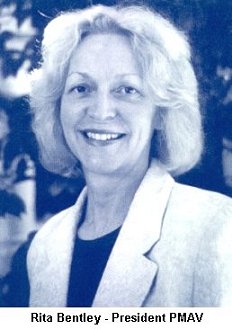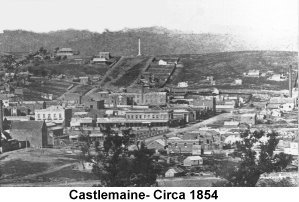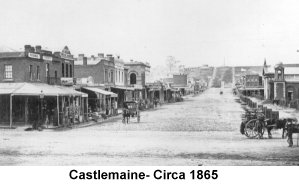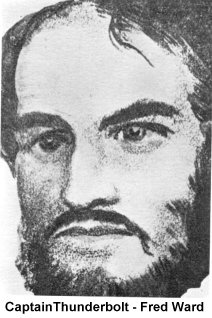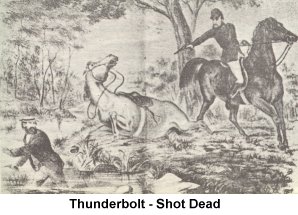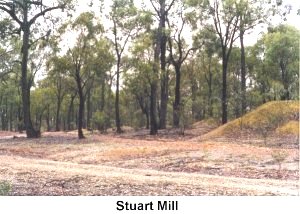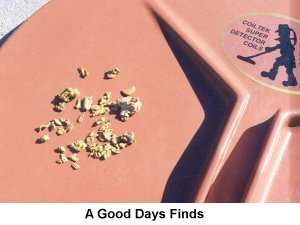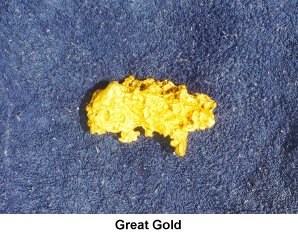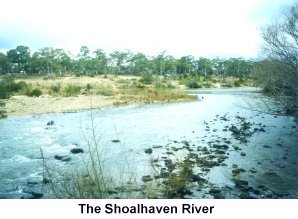
| December 2001 | |||||||||||||||
|
|||||||||||||||
Contents
|
|||||||||||||||
1. EDITORIAL This month Gold Net Australia reached another milestone. We have topped 50,000 hits on the site. It is always pleasing to see steady growth - and we are certainly achieving that. Invitations to participate in the Gold Expo have been sent and a promising response has resulted. It appears most of the exhibitors that attended last year will again be attending - and the Expo will be positively promoted throughout the goldfields regions.
Our overall readership has increased steadily this year and in accepted commercial terms has now reached a figure of 9,000. We have readers from all over the world - with a strong contingent from the Nordic countries. Finland, Sweden and Norway feature prominently.
It appears that the Box Iron Bark fight may be lost. It is a great tragedy that common sense and realistic debate could not win the day. It appears that democratic processes are not that well in the Garden State.
As clearly the majority have not been heard in this debate.
After the events of September 11th this year, we all wondered what the future held for us. I take this opportunity to wish you and your families a joyous Christmas and a bright and Prosperous New Year. Editor Email: [email protected]
All material in this magazine is copyright and may not be reproduced in any part or form whatsoever without written permission from the publisher.
|
|||||||||||||||
2. PMAV SUBMISSION TO POLITICIANS
 by Rita Bentley The PMAV have released their submission to members of the Victorian Parliament, who will be responsible for voting on the totally discredited and flawed report that the ECC relating to the Box Ironbark Issue. We reproduce this report for your perusal. To all Members of the Victorian Parliament The Environment Conservation Council's Final Report for the Box and Ironbark investigation was released to the public on 23rd August 2001. This Report has been some 6 years in the making and has cost millions of dollars of taxpayers' money plus countless hours of work by voluntary organisations, including the PMAV. 3,500 submissions were presented to the ECC from individuals and organisations in the hope that there would be a fair and balanced outcome.
Despite all this, the Report is a failure. The scientific process, which should be the pillar that underpins sound policy, has been adversely affected by the ECC'S myopic advocacy for new parks. The Report fails to address the real threats to biodiversity and continues to take the easy option of wrongly blaming traditional users for a claimed decrease in biodiversity. The ECC has failed to explicitly account for all known environmental risks in the Box Ironbark Forests and incorporate the management of them in the decision-making process. It also fails to consider more contemporary forms of land management similar to those adopted through the Regional Forest Agreement process. We have battled to maintain the very existence of a small-mining licence and the Miners Right. We have suffered under the indifference, disdain and green ideology of some within Government and the bureaucracy who have treated us like unwanted pests. We have experienced, and reluctantly accepted, the added imposition of increased bonds, regulation, requirements and reporting. We are suffering native title. We are seen as a relic of a bygone area - we do not fit the current vision of internationally significant activity. But we are real people and we deserve, and demand, adequate consideration. There is no evidence that our activities cause any damage to the environment and yet there are proposals to restrict activities - some to the extent that they will cease to exist. This is totally inequitable treatment that will not be accepted. Victoria proudly boasts of its golden heritage but is hounding those people who are continuing that heritage out of existence. You have the power to counter this wrong doing. Talk to your colleagues; use your vote in the party room and your voice in the House to protect the Rights of the individual. Government must not adopt ECC Recommendations that will adversely affect any activity unless convinced that there is proof that the activity is not sustainable at current levels.
Further Details are available from Rita Bentley, PMAV President, Specific comments and background The Prospectors and Miners Association of Victoria Inc.
The PMAV is the only body representing the interests of prospectors and small-scale miners in Victoria. We were established in 1980 and currently have an active membership of approximately 3,000. However there are an estimated 20,000 people who prospect in Victoria annually. The PMAV firmly believes that the ECC's Recommendations are not backed by appropriate science or proof and that they are written from an ideological perspective. To make the major changes to land use that the ECC are proposing without evidence to support their claims would be a grave injustice. Prospecting In Victoria, prospecting is primarily regulated by the Mineral Resources Development Act where it is referred to as 'searching'. Sections 55 -58 specifically refer.
Prospectors are generally compliant toward all statutory requirements. There has been no recognition of this compliance level of prospectors. For years we have had access Rights removed with no evidence that we cause any damage. The ECC continue with this unjust process. The ECC have acknowledged the importance of prospectors to the economy of the region. However the ECC have made recommendations that would have significant negative effects on the prospecting industry. The Reports recommendations, if adopted, would mean an 85,400 hectare decrease in state forest areas. Prospectors have generally had access to state forest areas - this right of access to 85,400 hectares, much of which is goldfields, is being removed. Prospectors have lost access to the area contained in the newly proposed Heathcote/Graytown National Park. Part of this area was proposed as a state park in the Draft Report and prospecting was to be permitted but the area has been upgraded to a national park, more than doubled in size and prospecting is to be prohibited in all 12,833 hectares of it. The St Arnaud Range National Park is another considerable area of goldfields that we have lost. The area in which prospecting is banned has grown to 13,526 hectares. It is recommended that prospecting be generally permitted in the newly recommended Castlemaine National Heritage Park (7,442 hectares) and the Greater Bendigo National Park (25,682 hectares). This will be subject to land manager's discretion. In the past this discretion has been misused by land managers with particular ideologies to prohibit prospecting in huge areas of goldfields. We acknowledge the attempt by the ECC to correct this position and urge Parliament to ensure that the ECC's stated intentions are complied with. We have been trying to obtain a Government policy on prospecting in parks for some time - to no avail! Without high level guidance we expect the current misuse of the system to continue. The PMAV must be involved in the development of the process required for the exercise of land manager's discretion (Recommendation 9). Prospecting is to be prohibited in the vastly expanded Chiltern-Box Ironbark National Park except for an area 100m each side of Reedy Creek. This is unacceptable. The new park covers 21,943 hectares. The report fails to acknowledge or consider the importance of this area to both gold prospectors and gem fossickers. The PMAV submits that the entire new park should be available for prospecting and that there be a review of the current prohibition of prospecting in the existing park. There is some confusion in the Recommendations - in the Recommendation for the National Heritage Park at Castlemaine prospecting is to be permitted within designated zones and in other parks where prospecting is to be permitted outside designated zones. This obviously needs to move to a standard position - the PMAV has always believed that prospecting should only be excluded from areas of particular sensitivity and welcome this move towards a more equitable position. Many prospectors own dogs. Dogs are not allowed in all national parks or nature conservation reserves. The creation of NCR's over areas such as Wedderburn, Waanyarra, Caralulup, Havelock, etc.etc. will have considerable impact on dog owning prospectors and therefore the local economy. Dogs will not be permitted in the Greater Bendigo National Park (25,682 hectares) and we are seeking clarification regarding dogs in the (7,442 hectares) Castlemaine National Heritage Park. The impact on the loss of prospecting activity in the Wedderburn and Tarnagulla (Waanyarra) regions would be catastrophic to the local economy as they rely heavily on expenditure from this activity. Camping within nature conservation areas is expected to be very limited. Probably only in designated, and no doubt, small areas. This will have major implications to prospecting club activities. In the past there has been no encouragement of human activity within areas set aside primarily for nature conservation - we expect this to continue. Prospectors have had a continuous connection with the land in the goldfields for 150 years. This connection has been ignored. The consultant who prepared the social and economic assessment for the Report recommended that current restrictions on prospecting in parks, ie. the areas that have been excluded by land manager's discretion, be reviewed. This recommendation has not been adopted by the ECC. The PMAV believes that this is a major omission. The PMAV submits that there should be no further increase in the areas unavailable for prospecting and indeed there should be a review of all current prohibitions with a view to relaxing any restrictions deemed to be unwarranted. Small-scale mining
Small-scale mining is conducted on a Mining Licence issued under the Mineral Resources Development Act. Small-scale miners always rehabilitate their Licences, they never leave open pits and vegetation is always re-established. Many small-scale operations in the region are 'doze and detect' where earth-moving machinery is used to systematically remove and separately stockpile soil profiles to uncover the gold bearing gravels. This layer is metal detected for gold nuggets and then the stockpiles are returned in the reverse order ie topsoil on top. Contours are re-established and then re-seeding takes place. The area soon recovers. Other small-scale mines may be underground and accessed by a shaft or adit or alternatively a small washing plant may be used for alluvial gold, accessed in a similar fashion to a 'doze and detect' operation. It is rare for small-miners to use any chemicals during their processing. There have been occasions where larger mining operations have failed to rehabilitate their sites - leading to bad publicity. We repeat: small-scale miners always rehabilitate their Licences, they never leave open pits and vegetation is always re-established. It would be wrong to penalise responsible small-scale miners for the activities of a few larger scale, non-compliant miners, unfortunately this is what the ECC proposes. The PMAV believes that the concept of a land swap is unnecessary for small-scale mining and should only be required when the land cannot be satisfactorily rehabilitated, such as when open pits are left. It is inequitable for small-miners, who always rehabilitate their sites, to be treated the same way as larger companies who are permitted to leave holes open. The original intention of the land swap was that it only apply to areas where rehabilitation was not possible. Small miners generally work areas that have been degraded by historic past mining operations and the environment is actually improved by mining operations and subsequent rehabilitation. The ECC have failed to provide any evidence that there is any long-term negative impact to the environment from small-scale mining operations or prospecting. If there was any proof it would have been published and the VNPA and the ECC would have been shouting it from the rooftops! The consultant who prepared the social and economic survey suggested that a 'prospector's licence' should be introduced as an opportunity for smaller operators to explore an area prior to applying for a full mining licence. The PMAV supports this concept, but unfortunately this suggestion was not adopted by the ECC. The ECC have recommended that mining and exploration be allowed below the Greater Bendigo National Park, the Castlemaine National Heritage Park and the Deep Lead Nature Conservation Reserve - but only at depths of 100 metres or greater - this will obviously be of no use to small miners. All areas that are parks or reserves become 'Restricted Crown Land' under the Mineral Resources Development Act. Larger scale miners with their financial resources find accessing Restricted Crown Land extremely difficult - small-scale miners find it impossible! The 85,400 hectares that it is proposed leave the state forest category would effectively become unavailable for small-scale miners. There have been a couple of problems with mining in the past - generally of a medium scale run by entrepreneurs - but all of these problems were due to non-compliance or administration issues. Changing the law will not address these problems - tightening of processes will. Small-scale miners quite rightly feel that they are being hounded out of existence. Many small scale miners have considerable amounts of money invested in their businesses. These investments in machinery etc were done prior to the proposed changes and with the belief that mining would continue to be viable. The PMAV will be supporting claims for compensation from Government if the Recommendations are adopted. While Governments have spent millions of dollars encouraging and promoting the larger mining industry, small miners and prospectors just receive more and more demands to justify our existence. If the ECC's proposals are adopted then the small-scale mining industry that has existed in Victoria for 150 years will cease. With no evidence that we are doing any long-term harm this would be criminal! If there is evidence that this sector is causing long term damage to the environment then the PMAV would be pleased to see it with a view to addressing those impacts. Small-miners are being unjustly regulated out of existence. Government should instead consider ways of encouraging the small business sector of the mining industry. General The ECC repeatedly use the imaginary $2 million per year 'non-use' value given to the biodiversity 'value' of the parks and reserves. This is the monetary value given to the warm and fuzzy feeling people, generally in Melbourne, apparently have from knowing that Victoria's park and reserve system exists. The ECC have not given any monetary value to the 'non-use' value that a huge number of Victorians receive from knowing that they retain the opportunity to participate in traditionally Australian activities such as prospecting, dog walking etc. If the 'non-use' value is to be used on one side of the balance sheet it must be used on the other. It could also be argued that prospectors get a significant 'non-use' value from the possibility of finding the next million dollar gold nugget. We value this at $1 million per prospector. The only difference is we know this is ludicrous, but so is the ECC's $2 million. This phony value is highly subjective, easily fudged and can never be recovered in the market place. Without the phony $2 million 'non-use' value for biodiversity on the cost/benefit analysis, there are significant real economic losses to the people of both the region and Victoria as a whole. Government must consider this prior to making any decisions. The consultant who prepared the 'social and economic impact assessment' for the ECC acknowledged that the main beneficiaries of the $2 million 'non-use' value would be the more affluent members of society who do not generally live in the study area. This is another case of the city 'benefiting' at the cost of regional and rural Victoria. The Recommendations would put traditional forest workers out of business for the sake of people in Melbourne getting warm and fuzzy feelings knowing that parks and reserves exist in central Victoria - even if they never visit them. We think someone has lost the plot! The ECC are recommending major new national parks at Heathcote/Graytown, Greater Bendigo and a national heritage park at Castlemaine. None of these were proposed in the Draft Report and therefore no member of the community has had the opportunity to comment on these recommendations. The PMAV questions the enforceability of the recommendations and the costs involved of adequate management. We are sure that the $400,000 estimated for additional management of the new parks and reserves is only a fraction of the real cost. We still question the claim that the creation of these new parks will increase tourism. A claimed $970,000 increase in tourism expenditure is projected. Parks Victoria's visitor numbers indicate a drop in visitors to all current box ironbark parks over the past three years. The ECC have failed to give any proof that current forest based tourism ventures in the region are financially successful - we have given them proof to the contrary. Government has recently committed $10 million dollars to prop up the ailing tourism industry in Victoria. Unless tourism is self supporting it cannot be considered economically viable. Tourism in central Victoria relies heavily on volunteers to exist. Volunteers usually staff tourist information centres and it is only volunteers who work at attractions such as the Castlemaine Diggings Project - no real jobs are created. The ECC has given no proof that real jobs in tourism will replace real jobs lost in traditional industries. They have not given one example of successful public land based tourism in the region. All the significant mistakes in the ECC's Draft Report regarding tourism projections, timber production, gold production, job losses, extent of forest remaining, etc have barely been acknowledged by the ECC. Neither have all the people and groups who put in submissions based on the Draft Report's incorrect information been told about the Report's errors. The ECC have failed to give any consideration to the real threat to biodiversity ie the threats posed by pest plants and animals, use of agricultural chemicals, urban sprawl, clearing for hobby farms and vineyards, etc. The Report is clearly based on ideology rather than science. No evidence is given that current land uses are not sustainable. There is no evidence given that the ECC's proposals to lock up more areas in parks and reserves will have any positive effects for the environment. The ECC are completely out of touch with modern ecomanagement. They have not considered alternative dynamic and innovative land management strategies and instead have opted for, preconceived, na�ve and failed solutions. Processes: The PMAV has been very vocal in its criticisms of the ECC's processes. We detailed 8 pages of mistakes we easily found in the Draft Report - not bias but clear mistakes. The ECC privately responded to these mistakes, and acknowledged many, but have not publicly admitted their existence. The Chairman of the ECC, Prof. John Lovering, in a letter to the President of the Public Land Council undertook to have a master copy of the corrected Report available for public perusal. A recent check of this situation revealed that the ECC had failed to deliver on this undertaking. They have later claimed that a document regarding the mistakes was available but only if you asked for it - if you were not aware of the mistakes then you weren't told! However, David Bentley of the PMAV visited the offices of the ECC and repeatedly asked for 'any updates, alterations or changes, further publications or information that was available to the public'. He was specifically told that nothing further was available and that the latest available information was that in the Draft Report. The ECC were aware of the mistakes very shortly after the release of the Draft Report. At a PMAV meeting in Dunolly EC Councillor, Eda Ritchie, when questioned about the contents of a slide she was showing said 'yes we know the figures are wrong but they don't affect the outcomes' and then continued to use them at that and subsequent meetings. At a public meeting in Bendigo 350 bush users were given examples of the mistakes and were angry that a Report, that had the potential to put many of them out of work or destroy their recreational opportunities, should be so badly flawed. This meeting was attended by members of the ECC and politicians from the Labor and National parties. The PMAV wrote to the ECC suggesting the Report be withdrawn, corrected and reissued or at least to publish an erratum - they declined this opportunity. They are trying to hide that they so seriously stuffed up! Recent weeks have seen a lot of 'letters to the editor' appear from both those supporting parks and those against. EVERY time the case is put against parks the ECC leap in claiming misinformation. Recent coverage of a Victorian National Parks Association letter with a flagrant misuse of statistics that could almost be deemed an outright lie failed to see any response from the ECC. The ECC are now touring the region 'selling' their Report to Shire Councils and via newspapers. Surely the ECC's role finished when it handed the Report to Minister Garbutt? Community groups such as the PMAV cannot compete with the resources available to statutory bodies. The ECC should be made to step aside and allow public debate to proceed. We could write a book on what has been wrong with the ECC process. Further details are available upon request. In closing: There is no proof that the ECC's Recommendations are necessary or will have the desired outcomes. Where is the proof, where is the science? Will you support putting country Victorians out of work because of an imaginary warm and fuzzy feeling some people are supposed to get from knowing more parks exist? We already have 4 million hectares of parks in Victoria. This current park and reserve system is suffering from many years of inadequate funding. Surely a smaller, better quality park system is more acceptable than a huge park system that is in decay. The ECC are demanding world best practice for industry using public land yet they have failed to look beyond outmoded management practices in their investigation. The USA has responded to revelations that the practice of 'benign neglect' does not work by changing management of non-productive parks to the more contemporary 'actively managed disturbance' regime. With over 95% of public land in the region retaining its original extent of vegetation one has to ask 'where is the problem?' Editors Note: Gold Net Australia Online unreservedly supports the PMAV position. The abuse of public office by those responsible should not be tolerated, and representations to your local member of Parliament should be long and strong.
|
|||||||||||||||
|
|||||||||||||||
3. CASTLEMAINE CAPERS by Laurelle Murphy The year of 1851 in Australia was one of great excitement, activity and explosive wealth, as the discovery of the richest alluvial gold fields in the world would eventually reveal. But in those early days of discovery - there were sceptics who through their ignorance and position held back the flood of diggers that were to wash over the great southern continents gold fields from all over the world. The Mount Alexander Gold Field was one of the first discovered in Victoria, at least officially. During October 1851, the Chief Commissioner of Goldfields, Captain Wright, moved his headquarters to the junction of two creeks, the Barker's and Forest Creeks. Castlemaine now stands on this site.
The gold fields in this area were not just prolific - they were extensive and spread over a vast area. They spread to the east as far as Elphinstone and slightly beyond - from Fryerstown in the south and north to Barkers Creek. The pace of activity was frenzied, and although the recently introduced licence fee of 30 shillings per month for every male present on the gold fields was taking an effect, there were still plenty of takers who came for their share of the gold wealth.
With the gold fields commission established at Castlemaine, within a few short weeks a canvas city was almost established. Here, as the authorities has established their position early the tent city was well laid out and orderly. In the initial phase of the opening up of this gold field - many men were loath to operate in view of the high cost of the licence and the higher cost of the fines handed out to those who were prosecuted. But in time, the wealth of the area overwhelmed the costs, which was to most, not an impediment to be considered, in the whole equation. It was at this time that the golden wealth of the whole of Central Victoria took its toll on the every day running of the colony. All but two of the police force either resigned or deserted Melbourne - and up to 60 ships lay unmanned in Port Phillip Bay as the entire crews deserted to find their wealth. In fact most of the crews simply went to the gold fields - dug out a good share of gold then returned to the ships and set sail for the return journey to England again. Governor La Trobe moved to keep order in Melbourne and increased the licence fee to 3 pound per month as a deterrent, without success as the tide of diggers swept over the goldfields, with an epicentre near this great golden feast at Castlemaine. Wages offered in Melbourne which were 8 pound a week were offered at 120 pounds a week to encourage men to remain at their jobs. At that price many still abandoned their jobs for the great golden wealth that was there for the taking, especially in the initial stages of the digging frenzy.
Gold was by now pouring forth from the ground is ever increasing amounts. In some weeks alone over 100,000 ounces were taken under escort to Melbourne. As the population grew to some 25,000 people within 3 months of the gold field being proclaimed the intensity of the diggers were reaching a crescendo. New permanent buildings were being erected not only by the government, but by enterprising private individuals. For 6 months the gold continued to be wrought from this land. It seemed never endless, and the gold escorts continued to proceed to Melbourne with around 100,000 ounces a week. Arrivals on the field are at least 1,000 per week, and in some weeks the number exceeds 3,000. Over 185,000 official licences were issued during 1852, so just how many diggers were actually in this area could be gauged by this number. On November 1st 1853, Castlemaine is proclaimed a town. It probably was named after an area in Ireland that was associated with some of the government officials involved at the birth of the town. In any case the long association with the Irish connection has continued to this day. Castlemaine continued to be a central point for the gold diggings for the district and that is evident in the number of old buildings that can still be seen to this day. Although the town never expanded to the heights of Ballarat and Bendigo, during that eventful era it was certainly the main focus in the area. Some of the most vocal opponents of Governor La Trobe emanated from this area and opposition to his regime continued through his tenure. He was not a popular administrator at all. At one time a newspaper cheekily advertised in the following terms. "Wanted, a Governor. Apply to the people of Victoria". In June 1854 the population on the gold field at Castlemaine was about 27,000. The gold was still there and in good quantities. In 1854 alone the gold exported from Castlemaine was over 2,000,000 ounces. The amount of gold recovered could be measured in tons for several years from this prolific gold field.
During April 1855, a nugget weighing 1,023 ounces is found at Fryers Creek.
|
|||||||||||||||
|
|||||||||||||||
4. CAPTAIN THUNDERBOLT by Craig Wilson There were some very colourful bushrangers during the gold rush days in Australia. None more so than the amicable rascal who used the name "Captain Thunderbolt". His real name was far less auspicious - Fred Ward. Fred Ward was born at Wilberforce, not far from Sydney in 1836, and was probably the youngest of 10 children born to Michael and Sophia Ward. Fred's father has been transported as a convict for stealing liquor. He grew up in the harsh environment of the time, and became an outstanding horseman. He was employed as a groomsman on Tocal Station, Maitland. When he was about 20 he resigned, and was allegedly employed by one James Garbutt - to help him drive 75 horses to Windsor. As it turned out - these horses were stolen and Ward was arrested and convicted of receiving. He was sentenced to 10 years imprisonment at Cockatoo Island. After serving just 4 years he was granted a "ticket of leave", in July 1860. Shortly after this time he took up with the half caste aboriginal Mary Anne Bugg, He became very fond of Mary. His ticket of leave required him to report regularly to police - which he failed to do - and eventually when he did borrow a horse and reported at the Maitland Police Station he was promptly arrested and summarily convicted of horse stealing and returned to Cockatoo Island to serve the remainder of his sentence.
In the next day or two as he travelled the road towards Maitland, holding up all he encountered. Among those was Godfrey Parsons, who was taking his sick wife to Maitland. During the conversation Parsons claimed to only have 2 pounds with him - and "Thunderbolt" let him pass. Mrs. Parsons was crying at the time - perhaps at the prospect of losing 30 pounds she had on her person. Not long after this he was joined by his common law wife Mary Anne who had travelled from Sydney, and together they travelled further north into the Moonie District of Queensland, where he was employed as a station hand. After about 6 months here he drove a mob of cattle south with others to the Hunter Valley, in New South Wales.
As he was returning to Queensland he learnt that he had been discovered and that the police were waiting for him to return. Thunderbolt formed a gang and together they carried out several daring robberies in the New England District of Northern New south Wales. He was often pursued by police - but never returned fire. He simply concentrated on riding hard on his stolen charges to outdistance the police as quickly as he could. Ward spent as much time with his beloved Mary Anne as he could - but on several occasions when he was discovered in the bush by police parties he escaped and Mary Anne and the children were captured and she was usually charged with vagrancy, and the children left with friends, or in foster homes. She was usually discharged after a short time in prison, a she was seriously ill.
Captain Thunderbolt formed another gang at this time and committed many robberies in the district, sometimes in their company and at other times on his own. Fred Ward carried out some of these robberies in an intoxicated state, no doubt pining for his Mary Anne.
Fred continued his felonious ways for a further three years after the death of Mary Anne. However his days of highway robbery were fast drawing to a close.
Luck was with the mounted troopers on this day, and they caught up with Ward, who used his normal method of escape, which was to outride and out distance the police.
Ward had headed into the Chilcott's Swamp and when his horse was completely knocked up - he dismounted and swam across a deep creek. Walker moved to prevent his escape and shot Wards horse dead, as he continued the pursuit still mounted. Dragging him to the side of the creek and onto the bank - Constable Walker remounted and rode back to Uralla for assistance to bring the "body" into the town. When he returned the body of Fred Ward could not be found. The next day in better light after a short search he was found a distance away, amazingly still breathing. However, he did not survive the trip back to Uralla.
Captain Thunderbolt was buried in the Uralla cemetery. Today the grave of Thunderbolt is a major tourist attraction in Uralla.
|
|||||||||||||||
|
|||||||||||||||
|
5. TRIPPING TO STUART MILL  by Walter Forsythe I had told Wack that if the weather was inclement there was no way that I was going to venture out in winter, even for a good gold find. But true to form, on the Sunday we had marked on the calendar couple of weeks before, the day dawned, cool but bright and sunny. It was Wacks turn to decide where we would go and with this character, no one ever knew just where we would end up in the gold fields.
But right on time my old mate rocked up. He is a jovial character, with an infectious smile and an impish nature that endears him to all. I had thought he might be heading for Maryborough - or Dunolly, but no, he kept right on going. That really had me thinking. I just mused at what was left. Maybe Bealiba, or Redbank, but no - we kept heading due west. Unbeknown to me my mate had organised to get onto some private ground just near the Kara Kara State Park. Eventually we were at Stuart Mill. Now just exactly where we were here I have been asked not to say - but suffice to say that Stuart Mill was the location. Now just what deal he had done with the land owner I don't know - but the land owner was sure happy to see us, so the deal must have been very favourable to him.
But then Stuart Mill can produce all sorts of gold, as it had done in the past. It was simply a matter of just where at the time. It is reputed to still have good gold at depth, and the old guys from the area say that several reefs are still there at depth just waiting to be discovered again. In any case we were not looking for the deep reefs; we were going after surface gold. We were aiming to do it the easy way. Neither of us had upgraded to the GP Extreme from the 2200. So with the Minelab 2200 coupled with a Coiltek UFO, which by the way, I really like, I started to detect across the slopes which showed some white features. Wack on the other hand was using a Coiltek 14" double D coil. Now being on private ground one can usually expect a much better return that in the forests, which essentially have been thrashed. But the going was slow. Very few signals were coming from either of us - although we were working about 150 metres apart to ensure interference was minimised. Wack was digging on more occasions than I was, as he was working down the opposite slope and apparently in the past there had been some activity there. It is always a good way to find gold. Its one of the indicators when you stop digging up the lead from a .22, and start digging up old buttons and the like. It indicates that the diggers were here long long ago - and if the diggers were here, this is where you will find gold. Although my area looked good, it was not producing. Not even a decent signal, but I persisted in working the ground in a grid like manner, where I could see that Wack was continuing off to the west on a slope but in a line. And I could see him digging at time. After two solid hours I had only had two digs, both for very old wire. But I persisted, and ahead of me I could see the ground starting to change. There was more foliage and the slopes were more inclined, so I worked my way towards that area. I expected to have to change the UFO for a double D in this country and when I hit this ground, the mineralisation was intense, so off came the UFO and on went the 14" Double D. I was now on a parallel plane with Wack, who was digging more often. I decided to head town towards him so that by lunch time we could join up, compare notes and take a good rest. As soon as I moved down the slope with the new coil fitted, bingo, a really nice sound. You get the feeling that it is gold, where before, although almost sure it was not gold - I just had to dig to make sure. And yes - on my first dig here I scored a nice little nugget, clear and pure and I guessed about 3 grams or so.
At noon, we stopped, turned off and joined up. Sitting under a large gum tree enjoying the warmth of the sun, I asked my friend, just how well he had done. The wry grin spread from ear to ear, and without a word he pulled from his pocket his old film case and poured out about 7 pieces, totalling about an ounce, maybe a little more. I was impressed. He had done well, but in his own way as he always did - he kept the best for last. From his pocket he pulled a really nice ounce piece. It really was a beauty. Flat, and well shaped. Nuggets like this sell well, so I thought than that we would be in the dollars. We continued for two more hours, and then the weather started to close in and it started to rain. The afternoon had not been as productive, but it was worth the effort. In total when we got back into the ute we took stock and realised that between us for the day we had close to 3 ounces, including the one ounce piece. When we called into the land owner's house on the way out, Wack, with a grin from ear to ear, showed him the gold he had found and of course I produced mine. Usually one arranges to give a percentage to the land owner. Anything from 20 - 30 per cent is around the cost. The look on the land owner's face when he saw the ounce nugget was electrifying. Wack told me later that the arrangement was to be 20%, but with his usual generosity he just handed the land owner the one ounce piece and said, "It's all yours mate."
That's Wack for you. Generosity plus. On the way back I could not stop thinking of that lovely nugget - and the dollars it might have brought. But then it was my turn to grin, and to recognise just why Wack and I were mates. My trip to Stuart Mill had been rewarding in more ways than one.
|
|||||||||||||||
|
|||||||||||||||
6. TODAY'S HOT SPOTS by Sue "Goldie" Reynolds To try and exactly find the hot spots of today is not easy and consequently some assumptions have been made in deciding just where gold has been located. One can only ask and hopefully some sense comes from the finders, but as you can recognise not everyone will tell you where they did actually found their gold. However, that being said, perhaps we should firstly look at the best producing areas for this year. In Victoria, the two areas that are standing out this year are undoubtedly, Maryborough and Dunolly. Just like the old times, these two great areas are still giving up good gold. To locate exactly just where the nuggets are coming from at Maryborough is difficult, as they appear to be coming from different areas. Mosquito Flat and Golden Point to the south east of the town have done well this year. It is reputed that several larger nuggets came from Mosquito Flat this year, while the Golden Point area produced well.
Dunolly of course, is always a good producer. Nuggets are known to have come from the following areas, this year. Welshman's Gully, and further north at Pearson Gully, to the north of Dunolly. White Patch produced well this year - despite being a favourite place for detectorists. Then I guess that is why it's popular, as it continues to produce. South of the town at Bet Bet there were several good nuggets found, but most of these were on private ground. Surprisingly the Havelock State Forest gave up several nuggets, although this area is not well known as a hot spot. At Bendigo, the Whipstick continued to produce reasonably well - but small nuggets up to 15 grams seem to be the order of the day. The Adelaide Hill area produced well, as I can personally vouch for that area, having done well there on the one occasion I visited there this year. Again the private ground in the Epson region did well. What a pity most of the land holders there reserve their properties. In the Talbot Amherst area the ground to the west of Talbot in the vicinity of Granite Hill, to Granite Gully and Butchers Gully, produced well, and a large nugget is reputed to have come from that area. Somewhere in the vicinity of 20 ounces I am told. Both the Amherst and Talbot State forests close to the townships are still producing small gold in reasonable quantities, but again the most finds are now coming from private ground just west of Talbot. In the Golden West, the outstanding areas this year have been both Leonora and also Kalgoorlie itself. All too often detectorists head off into the areas in the Leonora area, when excellent gold finds are being made at Kal. itself. In fact Kalgoorlie has produced an exceptional amount of gold this year, no doubt with the recognition that good gold is still to be found near the City. Although the gold found had not been in large nuggets a good quantity of well weighted nuggets has come from ground west and north of the area. At Leonora, many good finds are evident. Perhaps not as many as in previous years, but never the less this area is still producing. The lakes east of Leonora and the surrounding areas, have produced well this year, in particular Lake Carey, which is incidentally always a good producer, if you can work through the mineralisation there. I have heard of good nuggets coming from north Queensland this year - but I am not in a position to actually confirm that this is so. Never the less - the Queensland gold fields are known to have been good producers in the past and this is expected to continue into the future. The Palmer River region being the outstanding contributor this year - or so I am told. In New South Wales, sluicing areas that have been producing well this year are still the old favourites. The Shoalhaven is always a winner, and there are several creeks and streams just east of Bathurst that have produced well this year. No doubt the gold is still there - it's just a matter of going and getting it. The area between Bathurst and Meadow Flat did well this year.
This is by no means a complete picture of gold recovery in Australia this year, but just a resume of the gold areas that I know have done well during the last 12 months. No doubt there will be other areas that are doing well. But without that personal knowledge comments are best left unsaid. No doubt the old areas are still producing well. There is still a lot of gold coming from the Golden Triangle despite many who will tell you it is detected out. Considering that gold dealers and sending about 1,000 ounces of small gold a month to the smelters, that tends to indicate that Victoria is still producing really well.
|
|||||||||||||||
|
|||||||||||||||
7. FLECKS ! - Glints from here and there
|
|||||||||||||||
GOLD NET AUSTRALIA - AWARDSLast year we reflected on the previous year and made some awards. This year we thought we would continue the practice and looked at who had performed meritoriously this year.
Again we have considered two awards for this year. Personality of the Year Rita Bentley
The monumental effort made this year in fighting the position adopted by the EEC and its attitude towards the closing of Parks to Fossickers, could only go to one person. Organisation of the Year The Prospectors' and Mines Association of Victoria The organisation has this year supported Prospectors and Fossickers in thier fight to keep the forests open to us all. After all they are our forests. The support provided has made a significant contribution in putting the case to keep the forests open to all. We offer our congratulations.
|
|||||||||||||||
|
|||||||||||||||
8. STRIKES Recent Finds
Sorry - no pics available this month. |
|||||||||||||||
|
|||||||||||||||
|
9. THE NEW LODE - Next Month's Issue
|
|||||||||||||||
|
|||||||||||||||
|
|||||||||||||||

